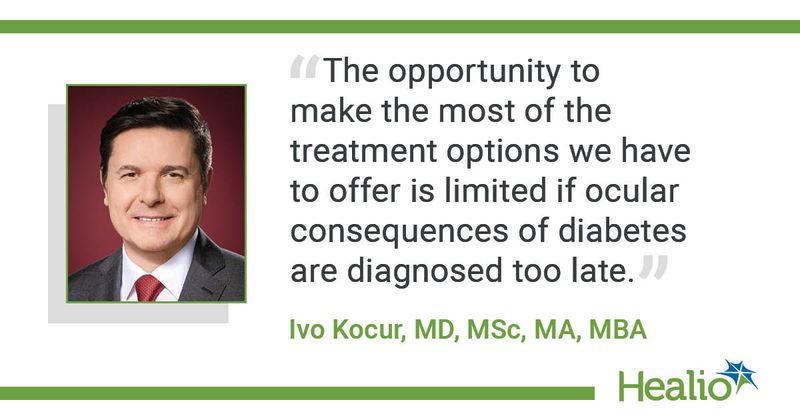Q&A: International Council of Ophthalmology supports WHO’s guide on DR screening
Click Here to Manage Email Alerts
The International Council of Ophthalmology participated in the launch of a diabetic retinopathy screening guide developed by the WHO Regional Office for Europe.
The guide is aimed at helping European policy makers, public health leaders and senior clinicians to initiate new programs or improve the effectiveness of those that already exist.

The 13 chapters of the guide provide a framework for a situational analysis of available resources and infrastructures, as well as a systematic pathway for designing effective diabetic retinopathy screening programs. Step by step, it examines the sequential stages of identifying and contacting the eligible population, testing, referral, diagnosis, treatment and follow-up, and reporting outcomes. It presents case studies and examples of good practices in low/middle-income and high-income countries, and it suggests strategies to overcome challenges, improve quality and increase awareness, considering important aspects such as leadership, coordination, management and financing.
To learn more about the guide, its scope and content, Healio/OSN spoke with Ivo Kocur, MD, MSc, MA, MBA, CEO of the ICO and previously senior medical officer of WHO, responsible for the global eye health agenda.
Question: Why was this guide needed?
Answer: Worldwide, diabetes is on the rise, due to population aging and lifestyle changes. Diabetic retinopathy (DR) affects approximately one-third of people with diabetes and is among the leading causes of preventable vision impairment and blindness. Vision loss due to DR often can be prevented if the appropriate strategies are implemented. However, most countries, also in a wealthy region such as Europe, do not have registries with nationwide data, well-implemented solid strategies or well-established procedures for monitoring to what extend these strategies are effective. A large proportion of people with diabetes remains undetected, particularly at the early stages. The opportunity to make the most of the treatment options we have to offer is limited if ocular consequences of diabetes are diagnosed too late. Often, the diagnosis is made on an individual level, while a coordinated national system of screening, referral and interprofessional team management is lacking.
Q: What is the role of the ICO?
A: The International Council of Ophthalmology recognizes that patients with DR, particularly those who do not receive timely treatment, have a high risk for vision impairment, and it shares WHO’s concerns about the growing prevalence of DR as a chronic age-related eye disease. The ICO has previously addressed this issue from a clinical perspective by developing the ICO Guidelines for Diabetic Eye Care as a practical support to ophthalmologists worldwide. ICO welcomes the progress of the WHO in preparing this resource and has contributed to some parts of the guide. On a more personal basis, I am a trained vitreoretinal surgeon and worked in a busy DR clinic, and this issue is close to my heart. While at WHO, supporting countries to build capacity for diabetes management has been among our priorities in addressing avoidable vision impairment.
Q: To whom is this guide addressed, and what are the core messages?
A: The guide is intended as a support for clinical ophthalmologists but also policy makers and public health authorities. It focuses on the need to cooperate to examine critically the countries’ current approach to DR, promote integrated people-centered eye care and develop systematic public health-oriented strategies.
Diabetes is a multifactorial disease, and good practice in place and collaboration among specialists help to manage, but also to detect the disease early. Many people with diabetes at the initial stages are unaware of their condition, and it can be through regular eye exams that they are diagnosed. Ophthalmologists can help diabetologists, internal medicine specialists and general practitioners, and vice versa other specialists may be able to detect and refer promptly the early onset of eye complications. The guide also stimulates ophthalmologists to look at diabetes-related eye disease in a broader health care-oriented perspective, have a separate registry for patients with diabetes, schedule regular visits for them and send them reminders. Proactive care is important because slow, progressive vision loss may not be noticed by patients themselves.
Finally, health authorities are invited to stimulate initiatives on a national level to raise awareness. More needs to be done for our communities around the world so that DR screening and regular monitoring with eye specialists are provided systematically and to those in need. Eye exams for people with diabetes are not a free service everywhere, so from a public health perspective, there is a lot we need to improve for this group of patients.
Q: How can this guide assist in developing screening programs for DR?
A: In the guide there are examples from countries that have efficient screening programs in place or have taken important steps in that direction. These good practices and experiences shared through this publication offer plenty of useful suggestions and guidance on how to develop and implement successful programs elsewhere. The guide also highlights the challenges policy makers may encounter. It provides a framework for action to develop new DR screening programs or to improve existing programs, taking into account the different health systems and available resources of high-income vs. low/middle-income countries. It designs a pathway and guides us through each step with plenty of useful, practical advice.
With diabetes on the rise, and in the spirit of the WHO’s European Programme of Work 2020-2025 “United Action for Better Health,” this guide stimulates stakeholders to work together to control severe visual disabilities due to DR. Together, we need to build momentum for a community-based public health approach to DR, raising awareness, implementing screening and strengthening management.
The guide can be downloaded from the WHO website at www.euro.who.int/en/publications/abstracts/diabetic-retinopathy-screening-a-short-guide-2020.
For more information:
Ivo Kocur, MD, MSc, MA, MBA, can be reached at email: ikocur@icoph.org.
